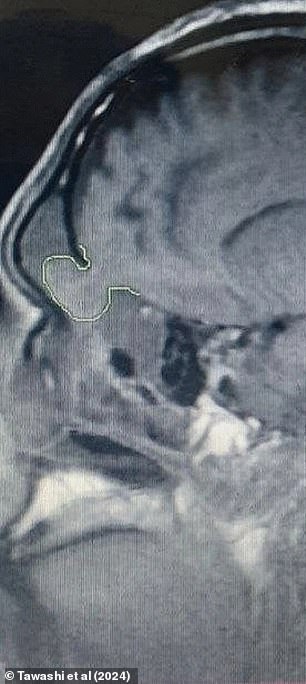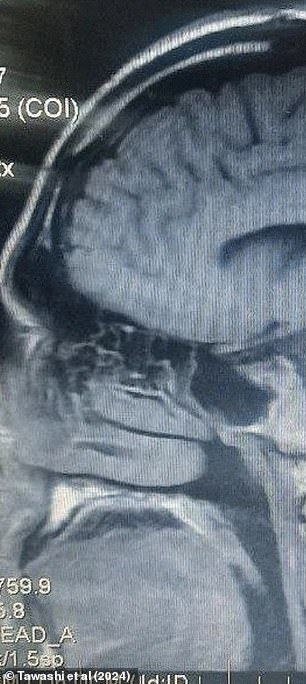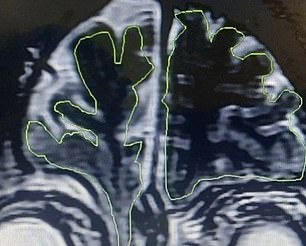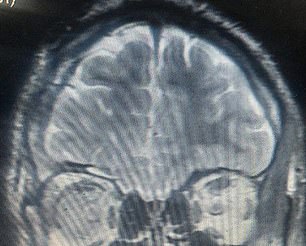Man, 20, with constant runny nose discovers his brain was sticking out and ‘leaking’
A 20-year-old man had been suffering from a runny nose for six years and it turned out that his brain was bulging through a hole in his skull.
The unidentified man from Syria suffered from a chronic runny nose, headaches and seizures after suffering a head injury.
What he mistook for a cold symptom turned out to be a “leak” of cerebrospinal fluid, a clear fluid that protects the brain and spinal column.
The problem began after the patient had been in a car accident six years earlier, in which he suffered a head injury but refused medical treatment at the time. He then began to suffer from moderate headaches and seizures, as well as a runny nose.
The 20-year-old, anonymous patient had been suffering from cerebrospinal fluid leakage for six years (stock photo)
After a scan of the man’s brain, doctors diagnosed him with traumatic encephalocele, a condition in which brain material leaks out through openings in the skull, such as the nasal cavity.
In most cases, an encephalocele is a rare birth defect in which brain tissue, and possibly parts of the brain itself, protrude through openings in the skull.
The birth defect occurs in approximately one in every 10,400 births, or about 375 babies per year.
In some cases, however, people can develop traumatic encephalocele after a trauma or injury to the head or brain. The condition can develop years after the original injury if the patient refuses treatment.
Because the condition is so rare, no figures are available for the number of traumatic encephaloceles that occur each year in the US.
However, one study estimates that a nasal encephalocele like the 20-year-old’s occurs in one in 40,000 live births in the US each year.
According to the Syrian patient case reportCSF leakage occurs in approximately 10 to 30 percent of basilar skull fractures.
Loss of CSF can damage blood flow to the brain and brain function. It also increases the risk of brain injury because CSF acts as a protective cushion for the organ.
Each type of encephalocele is treated with surgery to repair the rupture and close any open layers so that no more tissue or brain material can leak out of the skull.
In the case of the Syrian patient, the man refused initial treatment for his injuries when he was taken to hospital after his car accident.
After suffering from headaches and seizures for years, the man developed meningitis two months before he reported to the hospital due to nasal leakage of cerebrospinal fluid.
He was admitted to intensive care for a month and underwent an MRI scan of his brain.
The scan revealed that he had a skull fracture and an encephalocele had developed in his nasal cavity.
His brain tissue and meninges (the layers that protect the brain and spinal column) were bulging through the skull fracture, with “significant extension” into the right hemispheres, which were filled with cerebrospinal fluid.


The left image shows the man’s encephalocele in his nasal cavity and the right image shows the resolution of the man’s encephalocele in his nasal cavity after surgery


The left image shows the encephalocele pushed through the patient’s skull into his nasal cavity and the right image shows the patient’s brain after removal of the encephalocele
Doctors recommended surgery to repair the hernia, but the patient refused medical care.
When he returned to the hospital for a check-up two months later, another MRI showed the same thing and surgery was recommended again.
Eventually, the patient relented and underwent surgery in which a neurosurgeon replaced the tissue and matter that had leaked through the patient’s nasal cavity back into its normal place.
The doctor also repaired the damaged meninges and reconstructed the skull base where the fracture had damaged it with medical cement and glue.
The patient recovered well and was sent home two days later.
At a follow-up visit two months later, an MRI revealed that the patient’s encephalocele had completely closed and that the damage the bulge had caused to the brain and surrounding areas had healed.
The man also no longer suffered from headaches, runny nose and seizures.
Doctors in the case report warned that while traumatic encephalocele is “a rare and unexpected complication of trauma,” doctors should evaluate patients for it “because of the life-threatening consequences.”
